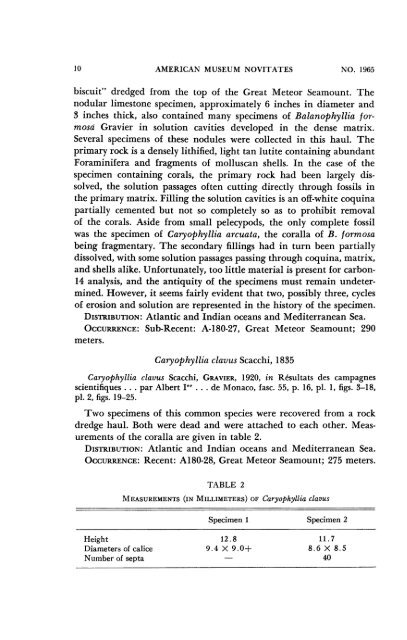MXieuicanJAuscum - American Museum of Natural History
MXieuicanJAuscum - American Museum of Natural History
MXieuicanJAuscum - American Museum of Natural History
You also want an ePaper? Increase the reach of your titles
YUMPU automatically turns print PDFs into web optimized ePapers that Google loves.
10 AMERICAN MUSEUM NOVITATES<br />
NO0. 1965<br />
biscuit" dredged from the top <strong>of</strong> the Great Meteor Seamount. The<br />
nodular limestone specimen, approximately 6 inches in diameter and<br />
3 inches thick, also contained many specimens <strong>of</strong> Balanophyllia formosa<br />
Gravier in solution cavities developed in the dense matrix.<br />
Several specimens <strong>of</strong> these nodules were collected in this haul. The<br />
primary rock is a densely lithified, light tan lutite containing abundant<br />
Foraminifera and fragments <strong>of</strong> molluscan shells. In the case <strong>of</strong> the<br />
specimen containing corals, the primary rock had been largely dissolved,<br />
the solution passages <strong>of</strong>ten cutting directly through fossils in<br />
the primary matrix. Filling the solution cavities is an <strong>of</strong>f-white coquina<br />
partially cemented but not so completely so as to prohibit removal<br />
<strong>of</strong> the corals. Aside from small pelecypods, the only complete fossil<br />
was the specimen <strong>of</strong> Caryophyllia arcuata, the coralla <strong>of</strong> B. formosa<br />
being fragmentary. The secondary fillings had in turn been partially<br />
dissolved, with some solution passages passing through coquina, matrix,<br />
and shells alike. Unfortunately, too little material is present for carbon-<br />
14 analysis, and the antiquity <strong>of</strong> the specimens must remain undetermined.<br />
However, it seems fairly evident that two, possibly three, cycles<br />
<strong>of</strong> erosion and solution are represented in the history <strong>of</strong> the specimen.<br />
DISTRIBUTION: Atlantic and Indian oceans and Mediterranean Sea.<br />
OCCURRENCE: Sub-Recent: A-180-27, Great Meteor Seamount; 290<br />
meters.<br />
Caryophyllia clavus Scacchi, 1835<br />
Caryophyllia clavus Scacchi, GRAvIER, 1920, in R6sultats des campagnes<br />
scientifiques ... par Albert Ier ... de Monaco, fasc. 55, p. 16, pl. 1, figs. 3-18,<br />
pl. 2, figs. 19-25.<br />
Two specimens <strong>of</strong> this common species were recovered from a rock<br />
dredge haul. Both were dead and were attached to each other. Measurements<br />
<strong>of</strong> the coralla are given in table 2.<br />
DISTRIBUTION: Atlantic and Indian oceans and Mediterranean Sea.<br />
OCCURRENCE: Recent: A180-28, Great Meteor Seamount; 275 meters.<br />
TABLE 2<br />
MEASUREMENTS (IN MILLIMETERS) OF Caryophyllia clavus<br />
Specimen 1 Specimen 2<br />
Height 12.8 11.7<br />
Diameters <strong>of</strong> calice 9.4 X 9.0+ 8.6 X 8.5<br />
Number <strong>of</strong> septa 40
















